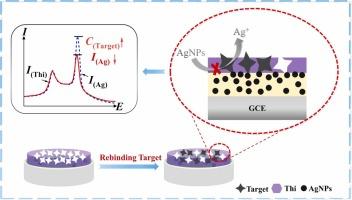一种基于银和离子液体共功能化MXene的新型比例分子印迹电化学传感器,用于高灵敏度和选择性检测展霉素
IF 3.7
1区 化学
Q1 CHEMISTRY, ANALYTICAL
引用次数: 0
摘要
本文设计了一种基于银纳米粒子(AgNPs)和离子液体(IL)共改性Ti2NTx (AgNPs@Ti2NTx@IL)的新型比例分子印迹电化学传感器(MIP-RECS),用于展青霉素(PAT)的检测。首先,通过原位还原和自组装法制备AgNPs@Ti2NTx@IL纳米复合材料,然后将其浇铸在玻碳电极(GCE)上,构建具有优异导电性和高表面积的电化学界面。然后,以硫氨酸(Thi)和PAT作为功能单体和模板分子,通过电聚合技术将MIP沉积在改性GCE的纳米复合材料上。在传感平台中,Thi和AgNPs产生的氧化峰分别作为参考和探测信号。参比的引入有效地消除了矩阵效应的影响。同时,由于AgNPs@Ti2NTx@IL纳米复合材料的高导电性和大表面积,大大改善了Ag探针的氧化信号。因此,MIP-RECS具有较宽的线性范围、极低的检出下限(LOD)、高选择性和良好的重复性。此外,传感器的线性范围和lod可以通过Ag的量来控制,突出了其在不同类型的实际样品中的鲁棒性。此外,该传感模型可用于灵敏检测其他氧化还原活性较差的残留物,如吡虫啉和儿茶酚,突出了其通用性和通用性。本文章由计算机程序翻译,如有差异,请以英文原文为准。

A novel ratiometric molecularly imprinted electrochemical sensor based on Ag and ionic liquid co-functionalized MXene for highly sensitive and selective detection of patulin
Herein, a novel ratiometric molecularly imprinted electrochemical sensor (MIP-RECS) based on Ag nanoparticles (AgNPs) and ionic liquid (IL) co-modified Ti2NTx (AgNPs@Ti2NTx@IL) was developed for the determination of patulin (PAT). Firstly, the AgNPs@Ti2NTx@IL nanocomposite, was prepared by an in situ reduction and self-assembled method, and then, was cast on the glassy carbon electrode (GCE) to build an electrochemical interface with excellent conductivity and high surface area. After that, the MIP was deposited on the nanocomposite modified GCE by the electro-polymerization technique, with thionine (Thi) and PAT as functional monomer and template molecules. In the sensing platform, the oxidation peaks generated by Thi and AgNPs were used as reference and probe signal, respectively. The introduction of reference effectively eliminates the influence of the matrix effect. At the same time, the oxidation signal of the Ag probe is greatly improved by the high conductivity and large surface area of the AgNPs@Ti2NTx@IL nanocomposite. Therefore, the MIP-RECS presented a wide linear range, a very low low limit of detection (LOD), together with high selectivity and excellent repeatability. Additionally, the linearity ranges and LODs of the sensor can be controlled by the amount of Ag, highlighting its robustness in different types of real samples. Furthermore, this sensing model can be used to sensitively detect other residues with poor redox activity, such as imidacloprid and catechol, highlighting its versatility and universality.
求助全文
通过发布文献求助,成功后即可免费获取论文全文。
去求助
来源期刊

Sensors and Actuators B: Chemical
工程技术-电化学
CiteScore
14.60
自引率
11.90%
发文量
1776
审稿时长
3.2 months
期刊介绍:
Sensors & Actuators, B: Chemical is an international journal focused on the research and development of chemical transducers. It covers chemical sensors and biosensors, chemical actuators, and analytical microsystems. The journal is interdisciplinary, aiming to publish original works showcasing substantial advancements beyond the current state of the art in these fields, with practical applicability to solving meaningful analytical problems. Review articles are accepted by invitation from an Editor of the journal.
 求助内容:
求助内容: 应助结果提醒方式:
应助结果提醒方式:


